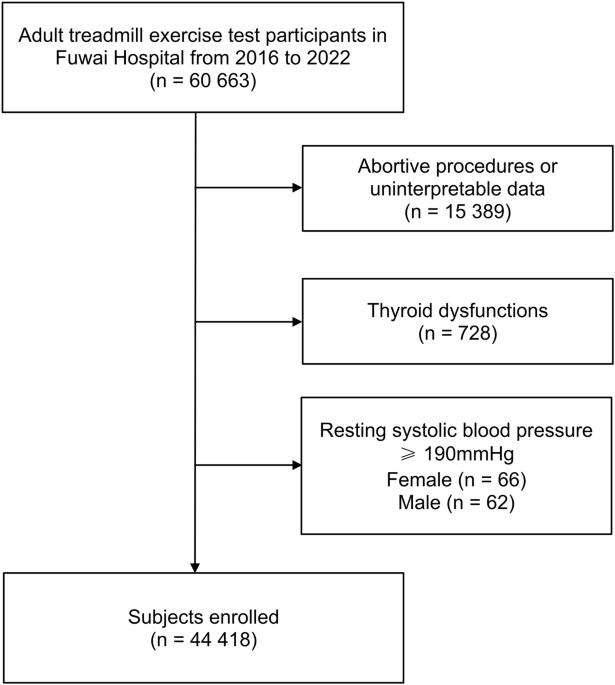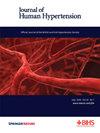收缩压对运动测试反应的性别差异:现实世界的临床分析。
IF 3.4
4区 医学
Q2 PERIPHERAL VASCULAR DISEASE
引用次数: 0
摘要
美国心脏协会(American Heart Association)建议,根据年轻健康人群的数据,对运动后的过度收缩压反应(ESBPR)设定性别特异性阈值。然而,在现实世界的临床环境中,它们的适用性和收缩压(SBP)对运动反应的性别差异仍不清楚。我们对2016-2022年在阜外医院接受跑步机运动测试的44 418名成年人(40.6%为女性)进行了横断面研究,平均年龄49岁。ESBPR定义为运动时收缩压峰值男性≥210 mmHg,女性≥190 mmHg。采用按性别分层的多变量回归模型来探讨性别是否会改变运动后收缩压反应的年龄相关模式。ESBPR在女性中的患病率是男性的5倍多(10.1比1.9%,P本文章由计算机程序翻译,如有差异,请以英文原文为准。

Sex differences in systolic blood pressure response to exercise testing: a real-world clinical analysis
The American Heart Association recommends sex-specific thresholds for defining exaggerated systolic blood pressure response to exercise (ESBPR), primarily based on data from young healthy populations. However, their applicability and the sex differences in systolic blood pressure (SBP) response to exercise in real-world clinical settings remain unclear. We conducted a cross-sectional study of 44 418 adults (40.6% female) with a mean age of 49, who underwent treadmill exercise testing at Fuwai Hospital from 2016–2022. ESBPR was defined as peak SBP during exercise ≥ 210 mmHg for males and ≥ 190 mmHg for females. Multivariate regression models stratified by sex were used to explore whether sex modifies age-related patterns in SBP response to exercise. ESBPR was over five times more prevalent in females than males (10.1 vs. 1.9%, P < 0.001). While the mean, 90th, and 95th percentiles of peak SBP were at least 12 mmHg higher in males than females in younger age groups (18–44), the gap narrowed to less than 4 mmHg in older age groups (≥45). Stratified multivariate analysis revealed that age was a strong predictor of ESBPR in females but not in males. Using age ≥ 51 as a proxy for menopause, females older than 51 had significantly higher odds of ESBPR compared to younger females (adjusted OR: 1.904, 95% CI: 1.683–2.155, P < 0.001). Our findings reveal that females and males display distinct age-related patterns in SBP response to exercise. The lower threshold for females may disproportionately classify postmenopausal females as abnormal.
求助全文
通过发布文献求助,成功后即可免费获取论文全文。
去求助
来源期刊

Journal of Human Hypertension
医学-外周血管病
CiteScore
5.20
自引率
3.70%
发文量
126
审稿时长
6-12 weeks
期刊介绍:
Journal of Human Hypertension is published monthly and is of interest to health care professionals who deal with hypertension (specialists, internists, primary care physicians) and public health workers. We believe that our patients benefit from robust scientific data that are based on well conducted clinical trials. We also believe that basic sciences are the foundations on which we build our knowledge of clinical conditions and their management. Towards this end, although we are primarily a clinical based journal, we also welcome suitable basic sciences studies that promote our understanding of human hypertension.
The journal aims to perform the dual role of increasing knowledge in the field of high blood pressure as well as improving the standard of care of patients. The editors will consider for publication all suitable papers dealing directly or indirectly with clinical aspects of hypertension, including but not limited to epidemiology, pathophysiology, therapeutics and basic sciences involving human subjects or tissues. We also consider papers from all specialties such as ophthalmology, cardiology, nephrology, obstetrics and stroke medicine that deal with the various aspects of hypertension and its complications.
 求助内容:
求助内容: 应助结果提醒方式:
应助结果提醒方式:


